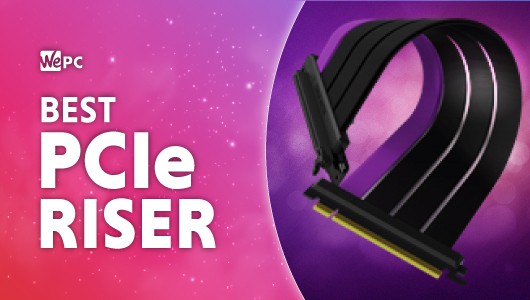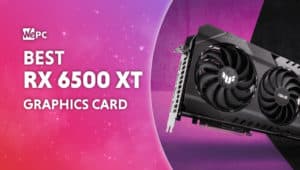Best PCIe riser in 2024
Which ones can rise up to the challenge of being best

Showing off your PC components has never been as popular so why not also do it for your GPU with a PCIe riser. GPU risers give you the flexibility to move your graphics card away from the slot. Either show off the fan side against your panel or move it somewhere further away.
One popular use of them is in micro or mini ITX builds that need to make use of most of their limited space. As well as making sure to not starve the card of fresh air to keep cool.
So trying to find which one is the best for you may be a tough task. We break it down and find what is the most important features to consider.
Our Top Picks


What is a PCIe riser?
Simply put a GPU riser is an extension of the PCIe slot. It is a simple pass-through that gives the flexibility of where to mount a graphics card. Instead of just straight into the motherboard slot, you can now move the card further away.
A good solution for those cleaner builds that hide away all the cables, you can simply hide the whole motherboard. Or it also allows for converting PCIe x1 slots and converting them to x16s.
They can also allow for better airflow for the ever-growing size of graphics cards. With bigger TDPs their designs are also growing. So fitting more PCIe cards onto the motherboard becomes harder and crowded. So PCIe risers let you move them around and help out their airflow.
Considerations for the best PCIe riser
In picking our best PCIe risers there are many factors that are considered. These are important in the performance of the risers and getting the most out of them.
PCIe standard
The PCIe standard is the interconnectivity of a motherboard connecting it to the expansion cards. In most cases, it is a graphics card and dictates how fast data can be transferred from one to the other.
With revisions, there is a change of speed and not utilizing that may cause some issues. Motherboards with PCIe 4.0 lanes connecting with a GPU using PCIe 4.0 can utilize that full potential. However, putting a PCIe 3.0 riser between them will limit it to that 3.0 speed.
So even though they physically may fit they won’t provide the same bandwidth. So as seen in the table below, an x16 in 4.0 will allow 31.508 GB/s but used in a 3.0 lane will hold the transfer rate. This drastic change will impact the performance.
|
PCIe version |
Transfer rate per lane (x1) [GB/s] | x4 [GB/s] | x8 [GB/s] |
x16 [GB/s] |
|
1.0 |
0.250 | 1.000 | 2.000 |
4.000 |
| 2.0 | 0.500 | 2.000 | 4.000 |
8.000 |
|
3.0 |
0.985 | 3.938 | 7.877 |
15.754 |
|
4.0 |
1.969 | 7.877 | 15.754 |
31.508 |
|
5.0 |
3.938 | 15.754 | 31.508 |
63.015 |
Price
They don’t cost the most, but they can vary a lot between the different choices. The newer generation tends to cost more expensive than the older ones. So when looking at the options it’s best to know you can utilize them fully. There’s no point getting a gen 4.0 if you only have a gen 3.0 motherboard.
There are also other features that will alter the price of the riser. One of which will be if the riser utilizes EMI shielding, or how long it is.
Length
There are varying lengths for PCIe risers. There is usually a choice of 200, 300, 600, or 1000mm. So a lot of choices to pick from to suit your needs and how far away you need your card.
However, there is a detriment to using longer risers. As with the length of data traveling the signal can deteriorate. And can suffer from more interference if the riser is not shielded.
Shielding
An important feature of PCIe risers is if they are EMI shielded. Inside your case, there is a lot of electronics, and electricity can produce electromagnetic radiation. This can then interfere with data signals passing through the riser.
To prevent this, they usually come with EMI shielding so it is an important factor when considering a GPU riser. As without it, there may be a loss of signal from your GPU while using it or some artifacts on screen.
The

In-depth Review


- Comes with a vertical mount if a case needs it
- Fast connection
- Great build quality
- Most expensive option
- Red highlight stands out
Not all cases allow for easy installation of a GPU riser cable. They need to be screwed into the bottom, where the PSU shroud is usually located, and might not have the required holes. The GPU as well needs to be attached to the vertical bracket to allow access to its IO. Even if your case may not have it this LinkUp riser comes with an adapter to help you out.
It easily replaces the back slot covers with the more needed vertical mount. Allowing easy conversion of any case to fit a vertical GPU mount. Moving your GPU down a flipping it 90° to show off the fan side and possibly provide better cooling to it.
The riser also utilizes the PCIe x16 standard meaning you’re not losing out on any performance by using the riser. As well as using individually shielded laneways to protect the data signal, to keep your signal integrity up.

- Great connection speed
- Dash of color with a purple highlight
- May not suit all builds
The CoolerMaster GPU riser is a great standalone option. If you already have the case that supports vertically mounted GPUs then just the cable is enough. The CoolerMaster option gives you a greatly reviewed product, which is a great choice.
With a 4th gen connection, it does offer you the whole performance of your graphics card. It also features highly shielded connectors with four separate lanes to maximize individual wrapping. Its 4th lane is also colored in CoolerMasters purple to bring some color to an otherwise monochrome market.
- Flexible design with individual ribbons
- Stealth all black design
- Easier to mount 90° connector
- More limited PCIe 3.0
If you’ve only got a PCIe 3.0 connector on your motherboard then there’s no need to splash out for the more expensive 4th gen risers. It’s enough to just use a PCIe 3.0 GPU riser as you’ll have better compatibility and otherwise no loss of speed while saving a bit of money.
The ROG Strix riser is a good option for that use case. With a stylistic all-black stealthy design, it can easily blend into your build keeping it clean and focusing on the important components. No RGB like ROG is known for that may take focus away from why you’re vertically mounting in the first place.
The card is also well shielded with 7 individually wrapped lanes keeping up great signal integrity. But also offers great bending and flexibility if you need to move it around a lot of obstacles. Along with their SafeSlot patent to keep up good performance and integrity.

- Stealthy monochrome design
- Good option for low price
- Easy installation
- Inflexible design
All the other options utilize a 90° female connector for your graphics card, that’s great for vertical mounting in your case. However, you may want to move the card elsewhere that needs a straight connector. That’s where Thermaltake offers a great PCIe 3.0 riser.
Being only third-gen it is a slower option for 4.0 builds so may not be a great choice for those. It also is only one large ribbon that is shielded, so could suffer from some interference, and be more unwieldy. It is however a cheaper option if you’re looking to save a bit without losing the flashiness of a riser.

- Allows use of 1x slots for a x16 card
- Cheaper option
- Limited to USB 3.0 speeds
Geared towards crypto miners these powered PCIe cards are a solution for utilizing those x1 slots for bigger cards. It allows the use of x16 cards from x1 slots, limiting bandwidth severely with their USB 3 connector. So more suited for low bandwidth applications and lower-powered expansion cards.
They also do utilize a SATA power connector and not just slot power or PCIe, but do allow for an x6 connector. This gives them the flexibility of power choices and better chaining of powering them. They do come cheap so it’s easy to buy multiple of them if needed.
Measuring in at 200mm they offer the same length expansion to move around your card. But that length lacks the same shielding although the lower bandwidth shouldn’t suffer as much loss as normal.
Final Word
There is our selection of the best PCIe risers. With a choice from the best on the market to ones specific to your needs. If you’re looking for starting your mining setup or moving your GPU as far away from your mobo as possible there is a choice for you.
WePC is reader-supported. When you buy through links on our site, we may earn an affiliate commission. Prices subject to change. Learn more











